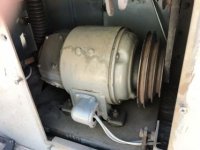hayseed
Plastic
- Joined
- Aug 5, 2010
- Location
- Tucson, AZ
I just picked up a Hardinge TM-UM mill that I was told had a three phase motor, but after I got it I found out it has a 230V DC motor. I'm fairly good with electric motors but the only DC motors I've dealt with were automotive related.
On investigation just what this motor is I found it has 3 sets of windings. Armature, series, and shunt. when I got this there was a variable autotransformer( better known as a Variac ) and two small full wave bridge rectifiers hooked up with some really sketchy wiring, down right scary wiring!
On the motor who ever did this fine job of wiring only wired in the shunt windings and the armature, the series windings were just left unhooked and taped. the motor does run like it is and the variable speed function does work. BUT, this motor is probably somewhat older than the mill itself which was made in 1955. I want this motor to last another 60+ years, so wiring it properly is my desire. As I understand it there are a few different ways it can be wired. what Im thinking I want to do is wire it as a long shunt compound motor. I want to retain the variable speed function and have the motor reversible. I'm cornfusing myself when trying to figure out the wiring for the reversing function.
Is there anyone more familiar than myself with these type of motor who is willing to help straighten out my muddled brain?

John from Tucson, AZ.
On investigation just what this motor is I found it has 3 sets of windings. Armature, series, and shunt. when I got this there was a variable autotransformer( better known as a Variac ) and two small full wave bridge rectifiers hooked up with some really sketchy wiring, down right scary wiring!
On the motor who ever did this fine job of wiring only wired in the shunt windings and the armature, the series windings were just left unhooked and taped. the motor does run like it is and the variable speed function does work. BUT, this motor is probably somewhat older than the mill itself which was made in 1955. I want this motor to last another 60+ years, so wiring it properly is my desire. As I understand it there are a few different ways it can be wired. what Im thinking I want to do is wire it as a long shunt compound motor. I want to retain the variable speed function and have the motor reversible. I'm cornfusing myself when trying to figure out the wiring for the reversing function.
Is there anyone more familiar than myself with these type of motor who is willing to help straighten out my muddled brain?


John from Tucson, AZ.







